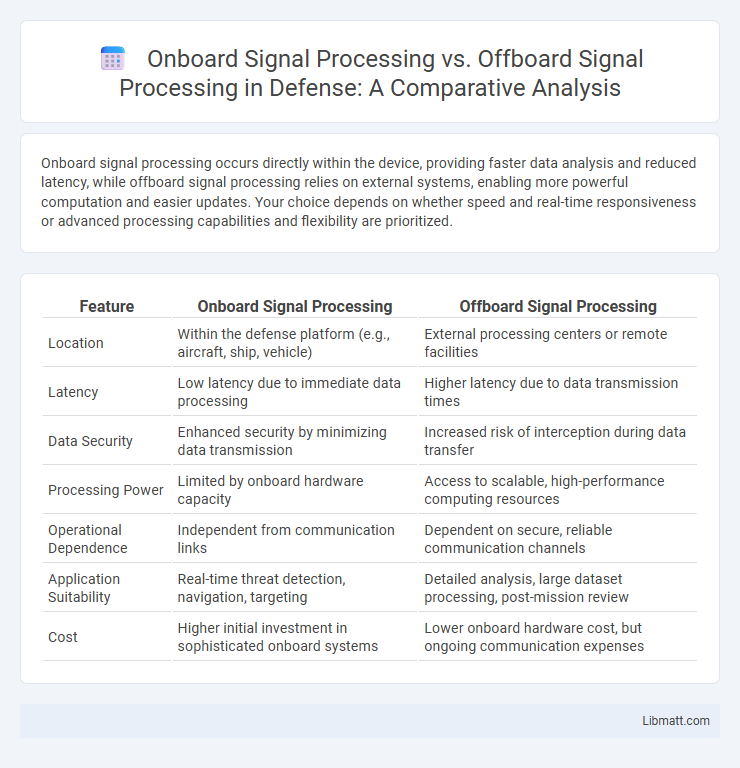Onboard signal processing occurs directly within the device, providing faster data analysis and reduced latency, while offboard signal processing relies on external systems, enabling more powerful computation and easier updates. Your choice depends on whether speed and real-time responsiveness or advanced processing capabilities and flexibility are prioritized.
Table of Comparison
| Feature | Onboard Signal Processing | Offboard Signal Processing |
|---|---|---|
| Location | Within the defense platform (e.g., aircraft, ship, vehicle) | External processing centers or remote facilities |
| Latency | Low latency due to immediate data processing | Higher latency due to data transmission times |
| Data Security | Enhanced security by minimizing data transmission | Increased risk of interception during data transfer |
| Processing Power | Limited by onboard hardware capacity | Access to scalable, high-performance computing resources |
| Operational Dependence | Independent from communication links | Dependent on secure, reliable communication channels |
| Application Suitability | Real-time threat detection, navigation, targeting | Detailed analysis, large dataset processing, post-mission review |
| Cost | Higher initial investment in sophisticated onboard systems | Lower onboard hardware cost, but ongoing communication expenses |
Introduction to Signal Processing Methods
Onboard signal processing integrates data analysis directly within the device, enabling immediate response and reduced latency for critical applications such as autonomous vehicles or aerospace systems. Offboard signal processing involves transmitting raw data to external systems or cloud servers, leveraging powerful computational resources for complex algorithms and extensive data storage. Your choice depends on requirements for real-time processing speed, power consumption, and system architecture flexibility.
Defining Onboard Signal Processing
Onboard signal processing refers to the execution of data analysis and filtering directly within the device or system where the signals are generated, enabling real-time decision-making and reduced latency. This approach minimizes the need for large data transfers by processing information locally, improving efficiency in applications like autonomous vehicles and industrial automation. Your system benefits from faster response times and enhanced reliability by leveraging onboard signal processing techniques.
Understanding Offboard Signal Processing
Offboard signal processing involves transmitting raw data from sensors or devices to external computing units for analysis, enabling more complex algorithms and higher processing power compared to onboard systems. This approach enhances your system's flexibility and scalability by leveraging cloud or edge computing resources, reducing the limitations imposed by onboard hardware constraints. Understanding offboard signal processing is crucial for applications requiring intensive data computation, real-time analytics, or integration with large datasets.
Key Differences Between Onboard and Offboard Processing
Onboard signal processing occurs directly within the device, enabling real-time data analysis and reducing latency for immediate decision-making. Offboard signal processing takes place externally, often on central servers or cloud platforms, allowing for more extensive computational resources and easier update management. The primary differences lie in processing location, speed of data handling, and resource availability, impacting system design and application efficiency.
Performance and Latency Considerations
Onboard signal processing offers superior performance by minimizing latency through immediate data analysis at the source, crucial for real-time applications like autonomous vehicles and medical devices. Offboard signal processing, while potentially providing more computational power and flexibility by leveraging cloud or central servers, introduces latency due to data transmission delays and network dependency. Your system's performance demands and latency sensitivity determine the optimal balance between onboard and offboard processing architectures.
Hardware and Infrastructure Requirements
Onboard signal processing demands compact, high-performance hardware integrated directly into devices, reducing latency and minimizing the need for external bandwidth but often increasing power consumption and design complexity. Offboard signal processing shifts the computational load to centralized servers or the cloud, requiring robust network infrastructure and high-speed data transmission to handle real-time processing efficiently. Your hardware choices impact infrastructure costs and scalability, with onboard solutions favoring edge computing and offboard solutions leveraging expansive data centers.
Scalability and Flexibility in Signal Processing
Onboard signal processing offers high scalability by integrating computational power directly within devices, enabling real-time analysis and immediate data handling without latency issues. Offboard signal processing provides greater flexibility by leveraging centralized resources, allowing you to easily upgrade algorithms and processing capabilities without hardware changes. Combining both approaches can optimize performance, balancing the rapid response of onboard systems with the adaptability of offboard solutions.
Security Implications and Data Privacy
Onboard signal processing enhances security by keeping sensitive data localized on your device, reducing exposure to external threats and minimizing data transmission risks. Offboard signal processing involves transmitting data to remote servers, increasing the potential for interception or unauthorized access during transit and storage. Prioritizing onboard processing supports stronger data privacy controls and compliance with regulations by limiting data sharing beyond your device.
Use Cases and Industry Applications
Onboard signal processing is crucial for real-time applications in autonomous vehicles and drones, enabling immediate data analysis and decision-making without latency. Offboard signal processing is preferred in telecommunications and remote sensing industries where large data sets are transferred to centralized servers for complex analysis and long-term storage. Both methods optimize performance in industries such as aerospace, defense, automotive, and IoT by balancing processing speed, power consumption, and data management needs.
Choosing the Right Signal Processing Approach
Choosing the right signal processing approach depends on your system's latency requirements, computational resources, and data transmission capabilities. Onboard signal processing offers real-time analysis and reduced data bandwidth by processing signals directly on the device, ideal for time-sensitive applications. Offboard signal processing, by contrast, leverages greater computational power and storage remotely, suitable when complex algorithms or large datasets need processing beyond the constraints of the onboard hardware.
Onboard signal processing vs Offboard signal processing Infographic

 libmatt.com
libmatt.com